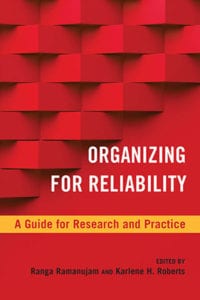Every day, airlines fly millions of people safely to their destinations, hospitals perform intricate surgeries that save lives, and commercial nuclear power plants pump out billions of kilowatt hours of electricity without incident.
All are complex organizations that conduct risky operations under time pressure yet operate largely free of major error—except the ones that don’t.

A new book edited by researchers at Vanderbilt University’s Owen Graduate School of Management and the University of California, Berkeley’s Haas School of Business offers research insights from the study of Highly Reliable Organizations (HROs), a field that has emerged over the past three decades and has changed the way high-profile disasters are evaluated and prevented.
“Organizing for Reliability – A Guide for Research and Practice,” edited by Rangaraj Ramanujam, the Richard M. and Betty Ruth Miller Professor of Management at the Owen School, and Karlene H. Roberts, Professor Emeritus at the Haas School, was released Feb. 27 by Stanford Business Books, an imprint of Stanford University Press. Read a Q&A with the editors here.
“We believed it was time to take stock of some of the most important research in one place, both for researchers to identify gaps and next steps, and for practitioners to pick up strategies to help them in making their organizations more reliable,” said Roberts, chair of the Center for Catastrophic Risk Management at the University of California, Berkeley. “Catastrophic accidents are still happening more often than anyone would like.”
Through 12 chapters from leading researchers on Highly Reliable Organizations (HROs), the editors showcase what has been learned over the past 30 years, in order to drive new research interest in the area and offer practitioners a guide to improving safety and reliability in their own organizations.
 Prior to the 1980s, accident analysis mostly centered around identifying technical and/or human causes of failures and resolving them through technological changes or training. Roberts was one of the first researchers to identify and examine highly reliable organizations—those that operate in extreme settings with no room for error—and uncover the systems, processes, and cultures that facilitated their success.
Prior to the 1980s, accident analysis mostly centered around identifying technical and/or human causes of failures and resolving them through technological changes or training. Roberts was one of the first researchers to identify and examine highly reliable organizations—those that operate in extreme settings with no room for error—and uncover the systems, processes, and cultures that facilitated their success.
“The task of keeping organizations reliable is intensely social. It requires lots of people interacting and coordinating with each other, so the quality of the social interactions affects the reliability of the outcomes,” says Ramanujam.
Adds Roberts, “It’s no longer informative to look at individuals in producing reliable and safe behavior in complex organizations. You have to look at the individual embedded in the group, the group embedded in the organization, and the organization embedded within its system of organizations, regulations, and other constraints.”
As interest in the field has grown, the impact of HRO research has extended beyond the world of academia. Major accident investigations, like that of the Columbia space shuttle, draw on it for analysis and recommendations, and industries such as nuclear power and chemicals have developed HRO operating manuals.
“I think that more organizations in more industries are facing shrinking margins of error,” says Ramanujam. “When it comes to reliability, organizations that used to operate with some flexibility are finding a less tolerant public.”
Chapters one and two, penned by Roberts and Ramanujam, respectively, offer an overview of HRO research history and perspective on reliability models. From there, HRO experts review the different facets of reliability, including mindful organizing, resilience, conflict, learning, communications, and inter-organizational reliability.
The final three chapters explore the application of the research, in disaster response situations, the healthcare industry, and other areas. A chapter penned by W. Earl Carnes includes perspectives from over 30 practitioners from various industries. Ramanujam and Roberts conclude the book with an epilogue that uncovers common themes and directions for future research.
“From a research standpoint, we hope readers will get an understanding of this active line of research with many important open questions, and we hope it will encourage them to undertake research to help answer them,” says Ramanujam. “From a practitioners standpoint, we hope this will alert them to advances being made on the research side and the resources available to them.”
Press Contacts:
Haas School of Business Media Relations
Laura Counts (510) 643-9977 [email protected]
Vanderbilt University News and Communications
615-322-NEWS (6397)